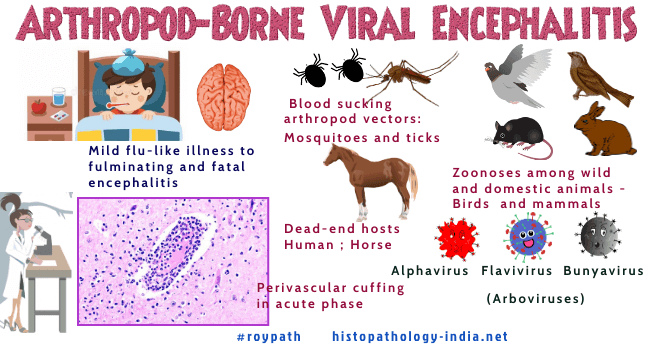|

Custom Search
|
|
Infectious Disease Online Pathology of Arthropod-Borne Viral Encephalitis
|

Syn: Arbovirus EncephalitisArthropod-borne viruses (arboviruses) are a large heterogeneous group of viruses transmitted between vertebrates by blood sucking arthropod vectors, such as mosquitoes and ticks. Replication of the virus in vertebrates causes severe illness, but in the arthropod it is harmless. Most virus infection are zoonoses among wild and domestic animals, especially birds and mammals. Man becomes accidentally infected if bitten by an infected arthropod. There are a number of arboviruses that cause meningoencephalitis in man, and each of the arthropod-borne viral encephalitis is confined to a particular geographic area and a specific vector. Visit: Amebic Meningoencephalitis In temperate zones, the climatic effects on the breeding of arthropods and the abundance of vertebrate hosts, results in seasonal variation in each disease. In tropical areas seasonal variation is less pronounced. The arthropod transmits the virus to a person from one of the reservoir animals but not from another person. People of all ages are susceptible to these diseases. Clinical symptoms range from a mild flu-like illness to fulminating and fatal encephalitis. The encephalitis usually begins abruptly, with fever, headache, disturbed consciousness and sometimes signs of meningitis, convulsions, or paralysis. The clinical course is usually short, not chronic as in some other viral infections. The diseases share many common features, but each type has a different course. For example, Eastern equine encephalitis is commonly a severe fulminant encephalitis that kills in a few days, where as Venezuelan Equine Encephalitis is a mild disease. Histologic findings in these encephalitides are usually confined to the central nervous system and are similar for all types. The lesions range from a mild meningitis with scattered lymphocytes to more severe inflammation of the gray matter, mainly around neurons, to prominent necrosis. Perivascular cuffing appears in the acute phase. In contrast to the other infections, Eastern equine encephalitis exhibits neutrophilic rather than lymphocytic inflammation and extensive meningitis, resembling a pyogenic infection. Vasculitis and thrombosis lead to numerous foci of necrosis, which extend into the white matter. Some of the necrotic foci resemble microabscesses. Some important arboviruses include: Eastern equine encephalitis viruses ; Western Equine Encephalitis ; Venezuelan Equine Encephalitis . Flaviviruses ( St.Louis Encephalitis ; Japanese Encephalitis ; Yellow Fever ; Dengue ; West Nile Virus ) ; Bunyaviruses (LaCrosse encephalitis; Reoviruses; Colorado tick fever).
|
|
|

